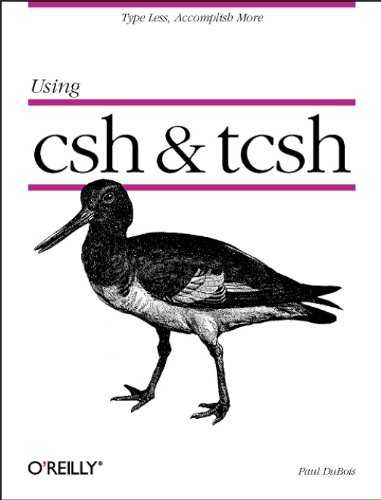
Inhaltsangabe
If you use UNIX, you probably use csh to type commands even if you've never heard of it. It's the standard shell (command line) on most UNIX systems. tcsh is an enhanced version that's freely available and highly recommended. Using csh & tcsh describes from the beginning how to use these shells interactively. More important, it shows how to get your work done faster with less typing. Even if you've used UNIX for years, techniques described in this book can make you more efficient. You'll learn how to:
- Make your prompt tell you where you are (no more pwd)
- Use what you've typed before (history)
- Type long command lines with very few keystrokes (command and filename completion)
- Remind yourself of filenames when in the middle of typing a command
- Edit a botched command instead of retyping it
Die Inhaltsangabe kann sich auf eine andere Ausgabe dieses Titels beziehen.
Über die Autorin bzw. den Autor
Paul DuBois is a programmer at the Wisconsin Regional Primate Research Center at the University of Wisconsin-Madison. He leads a quiet life with few interests outside of family, church, and programming.
Von der hinteren Coverseite
If you use UNIX, you probably use csh to type commands, even if you've never heard it. It's the standard shell (command line) on most UNIX systems. tcsh is an enhanced version of csh that's freely available and highly recommended. Using csh & tcsh describes how to use these shells interactively from the beginning. More importantly, it shows how to get more work done with less typing. Even if you've used UNIX for years, the techniques described in this book can make you more efficient. You'll learn how to make your prompt tell you where you are (no more pwd), use what you've typed before (history), type long command lines with very few keystrokes (command and filename completion), remind yourself of filenames when in the middle of typing a command, edit a botched command instead of retyping it, and let the computer correct command spelling for you. This book does not cover programming or script writing in csh or tsch because these tasks are better done with a different shell, such as sh (the Bourne shell) or a language like Perl.|
„Über diesen Titel“ kann sich auf eine andere Ausgabe dieses Titels beziehen.
Suchergebnisse für Using Csh & Tcsh: Type Less, Accomplish More (Nutshell...
Using csh & tcsh: Type Less, Accomplish More
Anbieter: BooksRun, Philadelphia, PA, USA
Paperback. Zustand: Fair. 1. The item might be beaten up but readable. May contain markings or highlighting, as well as stains, bent corners, or any other major defect, but the text is not obscured in any way. Artikel-Nr. 1565921321-7-1
Using CSH & Tcsh: Type Less, Accomplish More
Anbieter: ThriftBooks-Dallas, Dallas, TX, USA
Paperback. Zustand: Fair. No Jacket. Readable copy. Pages may have considerable notes/highlighting. ~ ThriftBooks: Read More, Spend Less. Artikel-Nr. G1565921321I5N00
Using Csh and Tcsh : Type Less, Accomplish More
Anbieter: Better World Books, Mishawaka, IN, USA
Zustand: Good. 1st Edition. Used book that is in clean, average condition without any missing pages. Artikel-Nr. 2693385-20
Using Csh and Tcsh : Type Less, Accomplish More
Anbieter: Better World Books: West, Reno, NV, USA
Zustand: Good. 1st Edition. Used book that is in clean, average condition without any missing pages. Artikel-Nr. 2693385-20
Using csh & tcsh (Nutshell Handbooks)
Anbieter: Wonder Book, Frederick, MD, USA
Zustand: Good. Good condition. A copy that has been read but remains intact. May contain markings such as bookplates, stamps, limited notes and highlighting, or a few light stains. Artikel-Nr. S07D-03495
Using csh & tcsh (Nutshell Handbooks)
Anbieter: Wonder Book, Frederick, MD, USA
Zustand: Very Good. Very Good condition. A copy that may have a few cosmetic defects. May also contain light spine creasing or a few markings such as an owner's name, short gifter's inscription or light stamp. Artikel-Nr. R12A-04099
Using CSH & TCSH: Type Less, Accomplish More (Nutshell Handbooks)
Anbieter: WorldofBooks, Goring-By-Sea, WS, Vereinigtes Königreich
Paperback. Zustand: Very Good. The book has been read, but is in excellent condition. Pages are intact and not marred by notes or highlighting. The spine remains undamaged. Artikel-Nr. GOR002855456
Gebraucht kaufen
Anzahl: 4 verfügbar
Using csh & tcsh (Nutshell Handbooks)
Anbieter: MusicMagpie, Stockport, Vereinigtes Königreich
Zustand: Very Good. 1749414881. 6/8/2025 8:34:41 PM. Artikel-Nr. U9781565921320
Gebraucht kaufen
Anzahl: 1 verfügbar
Using csh and tcsh
Anbieter: Bookbot, Prague, Tschechien
Softcover. Zustand: As New. Leichte Abnutzungen. If you use UNIX, you probably use csh to type commands even if you've never heard of it. It's the standard shell (command line) on most UNIX systems. tcsh is an enhanced version that's freely available and highly recommended. Using csh & tcsh describes from the beginning how to use these shells interactively. More important, it shows how to get your work done faster with less typing. Even if you've used UNIX for years, techniques described in this book can make you more efficient. You'll learn how This book does not cover programming or script writing in csh or tcsh because the tasks are better done with a different shell, such as sh (the Bourne shell) or a language like Perl. Artikel-Nr. e47f3212-4a42-4262-9ec3-115acfd9b62a
Gebraucht kaufen
Anzahl: 1 verfügbar
Using csh & tcsh (en anglais)
Anbieter: Ammareal, Morangis, Frankreich
Softcover. Zustand: Très bon. Ancien livre de bibliothèque. Edition 1995. Ammareal reverse jusqu'à 15% du prix net de cet article à des organisations caritatives. ENGLISH DESCRIPTION Book Condition: Used, Very good. Former library book. Edition 1995. Ammareal gives back up to 15% of this item's net price to charity organizations. Artikel-Nr. E-731-941
Gebraucht kaufen
Anzahl: 1 verfügbar
